KSEEB Solutions For Class 9 Maths Chapter 8 Quadrilaterals Points to Remember
- A quadrilateral is a closed figure obtained by joining four points (with no three points collinear) in an order.

- A diagonal is a line segment obtained on joining the opposite vertices.
- Two sides of a quadrilateral having no common endpoint are called opposite sides.
- Two angles of a quadrilateral having a common arm are called its adjacent angles.
- Two angles of a quadrilateral not having a common arm are called its opposite angles.
- A trapezium is a quadrilateral in which one pair of opposite sides are parallel.
| Class 9 Social Science | Class 9 Science | Class 9 Maths |
Read and Learn More KSEEB Solutions for Class 9 Maths
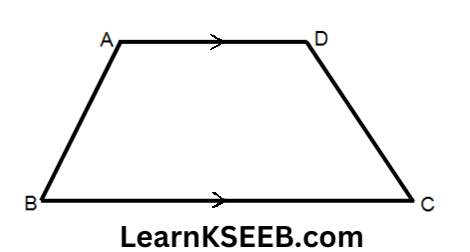
- If the non parallel sides of a trapezium are equal, then it is known as isosceles trapezium.

- A parallelogram is a quadrilateral in which both the pairs of opposite sides are parallel.
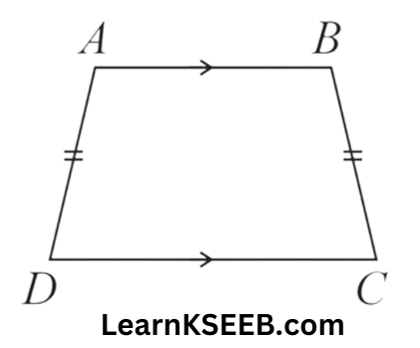
- A rectangle is a quadrilateral each of whose angle is 90°

KSEEB Class 9 Maths Chapter 8 Solutions PDF
- A Rhombus is a parallelogram all the sides of whose are equal.
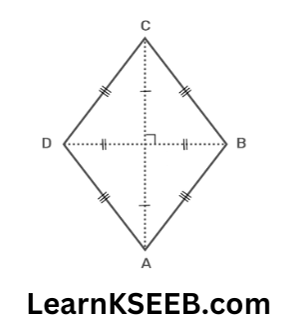
- A square is parallelogram all sides are equal & each angle is 90°

- A kite is a quadrilateral in which two pairs of adjacent sides are equal.
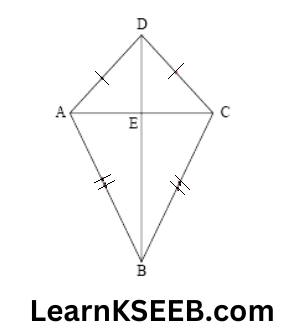
KSEEB Class 9 Maths Chapter 8 Quadrilaterals Exercises
Properties of parallelogram
- Opposite sides of a parallelogram are parallel
- A diagronal of a parallelogram divides it into two congruent triangles.
- Opposite sides of a parallelogram are equal.
- Opposite angles of a parallelogram are equal.
- Consecutive angles (conjoined angles) of a parallelogram are supplementary.
- Diagonals of a parallelogram bisect each other.
- If each pair of opposite sides of a quadrilateral is equal., then it is a parallelogram.
- If in a quadrilateral each pair of opposite angles is equal, then it is a parallelogram.
- If the diagonals of a quadrilateral bisect each other, then it is a parallelogram.
- If the diagonals of a quadrilateral bisect each other, then it is a parallelogram.
- A quadrilateral is a parallelogram , if a pair of opposite sides is equal & parallel.
- Square, rectangle & rhombus are all parallelograms.
- Kite & trapezium are not parallelogram.
- A square is a rectangle
- A square is a rhombus
- A parallelogram is a trapezium.
- Every rectangle is a parallelogram.
- It has all the properties of a parallelogram
-> All the interior angles of a rectangle are right angles.
-> The diagonals of a rectangle are equal. - Every rhombus is a parallelogram, it has all the properties of a parallelogram.
-> All the sides of a rhombus are equal.
-> Diagonals of a rhombus intersect at right angles.
-> Diagonals of a rhombus bisects its angles. - Every square is a parallelogram, it has all the properties of a parallelogram.
-> All sides are equal
-> All angles are equal to 90°
-> Diagonals are equal
-> Diagonals bisect each other at right angle.
-> Diagonals bisect the angles of vertex - The mid-point theorem.
- The line segment joining the mid-points of two sides of a triangle is parallel to the third side.
- Conversely the line drawn through the midpoint of one side of a triangle, parallel to another side bisects the third side.
Quadrilaterals Exercise 8.1
1. The angles of a quadrilateral are in the ratio 3:5:9:13. Find all the angles of the quadrilateral.
Solution: Let ABCD be a quadrilateral in which
\(\lfloor A\):\(\lfloor B\):\(\lfloor C\):\(\lfloor D\) = 3:5:9:13
Sum of the ratios = 3 + 5 + 9+ 13 = 30
Also \(\lfloor A\) + \(\lfloor B\)+ \(\lfloor C\)+ \(\lfloor D\)= 360°
(sum of all the angles of a quadrilateral is 360°)
\(\lfloor A\) = 3/30×360 = 36°
\(\lfloor B\) = 5/30 x 360 = 60°
\(\lfloor C\)= 9/30×360 = 108°
\(\lfloor D\) = 13/30x 360 = 150°
2. If the diagonals of a parallelogram are equal, then show that it is a rectangle
Solution:
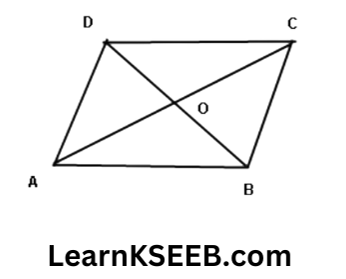
Given: In parallelogram ABCD
AC = BD
To prove : ||gm ABCD is a rectangle
Proof: In ΔABC and ABDA
AC = BD (given)
AB = BA (common)
BC = AD (oppsite sides of || gm ABCD)
∴ ΔACB ≅ ΔBDA (SSS rule)
\(\lfloor\mathrm{ABC}\) = \(\lfloor\mathrm{BAD}\) (cpct) …………………(1)
again AD || BC (opp. sides of ||gm ABCD & transversal AB intersects them)
∴ \(\lfloor\mathrm{BAD}\) + \(\lfloor\mathrm{ABC}\) = 180° ………………(2)
(sum of consecutive interior angles on the same side of a transversal is 180°)
from(1) &(2)
\(\lfloor\mathrm{BAD}\) = \(\lfloor\mathrm{ABC}\) = 90°
∴ \(\lfloor A\) = 90°
∴ ||gm ABCD is a rectangle.
3. Show that if the diagonals of a quadrilateral bisect each other at right angles then it is a rhombus.
Solution:
Given: ABCD is a quadrilateral whose diagonals AC & BD intersect each other at right angles at O.
To prove: Quadrilateral ABCD is a rhombus.

Proof: In ΔAOB = ΔAOD
AO = AO (common)
OB = AD (given)
\(\lfloor\mathrm{AOB}\) = \(\lfloor\mathrm{AOD}\) = 90°
ΔAOB = ΔAOD (SAS rule)
=> AB=AD ……………..(1)(cpct)
|||/y we can prove that
AB = BC …………….(2)
BC = CD ……………..(3)
CD =AD ………………(4)
from (1), (2), (3) & (4) we get
AB = BC = CD = DA
∴ Quadrilateral ABCD is a rhombus.
4. Show that the diagonals of a square are equal & bisect each other at right angles.
Solution:
Given: ABCD is a square
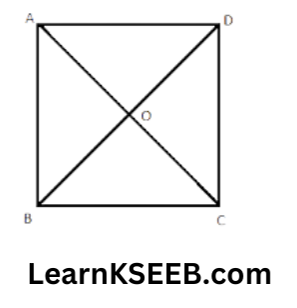
To prove: 1) AC = BD
2) AC & BD bisect each other at right angles.
Proof: 1) In AABC & ABAD AB = BA (common)
BC = AD (opp. sides of square)
\(\lfloor\mathrm{ABC}\) = \(\lfloor\mathrm{BAD}\)= 90°
∴ ΔABC ≅ ΔBAD (by SAS rule)
∴ AC = BD (cpct)
2) In ΔOAD and ΔOCB
AD = CB (Opp. sides of square ABCD)
\(\lfloor\mathrm{OAD}\) = \(\lfloor\mathrm{OCB}\)
(AD || BD & transversal AC intersects them)
\(\lfloor\mathrm{ODA}\) = \(\lfloor\mathrm{OBC}\)
(AD || BD & transversal BD intersects them)
∴ ΔOAD ≅ ΔOCB (ASA rule)
∴ OA = OC …………….(1)
|| ly we can prove that OB = OD ……………..(2)
from (1) & (2) we can say
AC & BD bisect each other
Again, in ΔOBA and ΔODA OB = OD (from (2))
BA=DA (opp. sides of square ABCD)
OA = OA (common)
∴ ΔOBA ≅ ΔODA (SSS rule)
=> \(\lfloor\mathrm{AOB}\) = \(\lfloor\mathrm{AOD}\) (cpct)
but \(\lfloor\mathrm{AOB}\) +\(\lfloor\mathrm{AOD}\) = 180° (linear pair)
∴ \(\lfloor\mathrm{AOB}\)=\(\lfloor\mathrm{AOD}\) = 90°
∴ AC & BD bisect each other at right angles.
5. Show that if the diagonals of a quadrilateral are equal & bisect each other at right angles, then it is square
Solution:
Given: The diagonals AC & BD of a quarilateralABCD are equal & bisect each other at right angles. A B
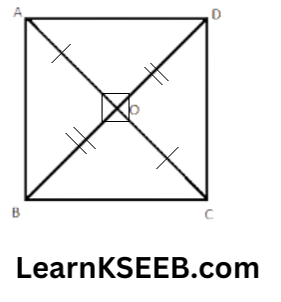
To prove: Quadrilateral ABCD is a square
Proof: In ΔOAD and ΔOCB
OA = OC (given)
OD = OB (given)
\(\lfloor\mathrm{AOD}\) =\(\lfloor\mathrm{COB}\) (vertically opp. angles)
∴ ΔOAD ≅ ΔOCB (SAS rule)
∴ AD= CB{CPCT)
∴ \(\lfloor\mathrm{ODA}\) = \(\lfloor\mathrm{OBC}\) (CPCT)
=>\(\lfloor\mathrm{BDA}\) = \(\lfloor\mathrm{DBC}\)
∴ AD || BC
Now, AD = CB & AD || CB
∴ Quadrilateral ABCD is a ||gm
In ΔAOB and ΔAOD
AO = AO (common)
OB = OD (given)
\(\lfloor\mathrm{AOB}\) = \(\lfloor\mathrm{AOD}\) = 90°
∴ ΔAOB ≅ ΔAOD (SAS rule)
∴ AB= AD (CPCT)
∴ ABCD is a ||gm &AB=AD
∴ ABCD is a rhombus.
Again in ΔABC and ΔBAD AC = BD (given)
BC = AD (ABCD is a rhombus)
AB = BA
∴ ΔABC ≅ ΔBAD (SSS rule)
\(\lfloor\mathrm{ABC}\) = \(\lfloor\mathrm{BAD}\) (CPCT)
AD || BC (opp. sides of ||gm ABCD & transversal AB intersects them)
∴ \(\lfloor\mathrm{ABC}\) + \(\lfloor\mathrm{BAD}\) = 180°
∴ \(\lfloor\mathrm{ABC}\) = \(\lfloor\mathrm{BAD}\) = 90°
|| ly \(\lfloor\mathrm{BCD}\) = \(\lfloor\mathrm{ADC}\) = 90°
∴ ABCD is a square
6. Diagonals AC of a parallelogram ABCD bisects \(\lfloor A\) (see figure) show that
1) it bisects \(\lfloor C\) also
2) ABCD is a rohmbous
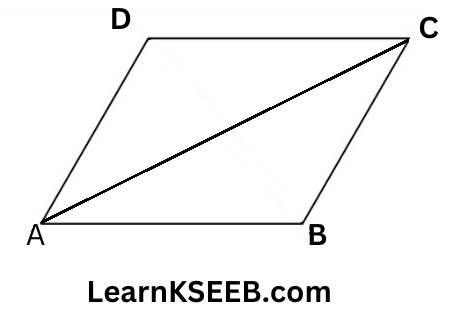
Solution:
Given: Diagonal AC of a parallelogram ABCD bisects \(\lfloor A\).
To prove: 1) it bisects \(\lfloor C\) also
2) ABCD is a rhombus
Proof: 1) In ΔADC and ΔCBA
AD = CB (opp. sides of ||gm ABCD)
CA = CA (common
DC = BA (opp. sides of ||gm ABCD)
∴ ΔADC ≅ ΔCBA (SSS congruence rule)
\(\lfloor\mathrm{ACD}\) = \(\lfloor\mathrm{CAB}\) (C.P.C.T.)
& \(\lfloor\mathrm{DAC}\) = \(\lfloor\mathrm{BCA}\) (C.P.C.T.)
but \(\lfloor\mathrm{CAB}\) = \(\lfloor\mathrm{DAC}\) (given)
∴ \(\lfloor\mathrm{ACD}\) = \(\lfloor\mathrm{BCA}\)
AC bisects \(\lfloor C\) also
2) from above \(\lfloor\mathrm{ACD}\) – \(\lfloor\mathrm{CAD}\)
AD = CD (sides opp. to equal angles of a Δle are equal)
∴ AB = BC = CD = DA(∵ ABCD is a ||gm)
∴ ABCD is a rhombus.
7. ABCD is a rhombus. Show that diagonal AC bisects \(\lfloor A\) as well as \(\lfloor C\) & diagonal BD bisects \(\lfloor B\) as well as \(\lfloor D\)
Solution:
Given: ABCD is a rhombus
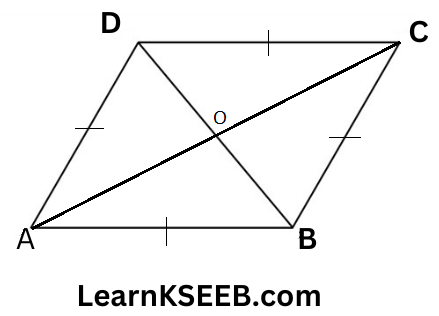
To prove: 1) Diagonal AC
bisects \(\lfloor A\)as well as \(\lfloor C\)
2) Diagonal BD bisects \(\lfloor B\) as well as \(\lfloor D\)
Proof: 1) ABCD is a rhombus.
AD = CD
\(\lfloor\mathrm{DAC}\) = \(\lfloor\mathrm{DCA}\) (angles opp. to equal sides of a Δle are equal)
from(1) &(2)
\(\lfloor\mathrm{DCA}\) = \(\lfloor\mathrm{BCA}\)
=> AC bisects \(\lfloor C\)
|| ly AC bisects \(\lfloor A\)
2) Proceeding || ly as in(1) above, we can prove that BD bisects \(\lfloor B\) as well as \(\lfloor D\)
Karnataka 9th Standard Maths Chapter 8 Notes
8. ABCD is a rectangle in which diagonal AC bisects \(\lfloor A\) as well as \(\lfloor C\). Show that
1) ABCD is a square
2) diagonal BD bisects \(\lfloor B\) as well as [\(\lfloor D\)
Solution:
Given: ABCD is a rectangle in which diagonal AC bisects \(\lfloor A\)as well as \(\lfloor C\)
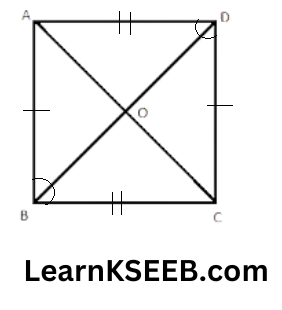
2) diagonal BD bisects \(\lfloor B\) as well as \(\lfloor D\)
Proof: 1) AB || DC & transversal AC intersects them
∴ \(\lfloor\mathrm{ACD}\) = \(\lfloor\mathrm{CAB}\) (alternate interior angle)
but \(\lfloor\mathrm{CAB}\) = \(\lfloor\mathrm{CAD}\)
∴ \(\lfloor\mathrm{ACD}\) = \(\lfloor\mathrm{CAD}\)
∴ AD = CD (sides opp. to equal angles of a Δle are equal)
ABCD is a square
2) In ΔBDA and ΔDBC
BD = DB (common)
DA=BC (sides of a square ABCD)
AB = DC (sides of a square ABCD)
ΔBDA ≅ ΔDBC (SSS rule)
∴ \(\lfloor\mathrm{ABD}\) = \(\lfloor\mathrm{CDB}\) (CPCT)
but \(\lfloor\mathrm{CDB}\) = \(\lfloor\mathrm{CBD}\) (∵ CB=CD)
∴ \(\lfloor\mathrm{ABD}\) = \(\lfloor\mathrm{CBD}\)
BD bisects \(\lfloor B\)
Now \(\lfloor\mathrm{ABD}\) =\(\lfloor\mathrm{CBD}\)
\(\lfloor\mathrm{ABD}\) = \(\lfloor\mathrm{ADB}\) (∵ AB=AD)
\(\lfloor\mathrm{CBD}\) = \(\lfloor\mathrm{CDB}\) (∵ CB=CD)
∴ \(\lfloor\mathrm{ADB}\) = \(\lfloor\mathrm{CDB}\)
=> BD bisects \(\lfloor D\)
9. In parallelogram ABCD, two points P& Q are taken on diagonal BD such that DP = BQ (see fig) show that

1) ΔAPD ≅ ΔCQB
2) AP=CQ
3) ΔAQB = ΔCPD
4) AQ = CP
5) APCQ is a parallelogram
Solution:
Given: In parallelogram ABCD, two points P & Q are taken on diagonal BD such that DP = BQ

To prove: 1) ΔAPD ≅ ΔCQB
2) AP = CQ
3) ΔAQB = ΔCPD
4) AQ = CP
5) APCQ is a parallelogram
Construction: Join AC to intersect BD at O.
Proof: 1) In ΔAPD and ΔCQB
AD || BC
( ∵ opp. sides of ||gm ABCD & a transversal BD intersects them)
∴ \(\lfloor\mathrm{ADB}\) = \(\lfloor\mathrm{CDB}\) (alternate interior angles)
=>\(\lfloor\mathrm{ADP}\)=\(\lfloor\mathrm{CBQ}\) ……………….(1)
DP = BQ …………………(2) (given)
AD = CB …………………(3) (opp. sides of ||gm ABCD)
ΔAPD ≅ ΔCQB (SAS rule)
2) ΔAPD ≅ ΔCQB (proved in (1) above)
∴ AP = CQ (C.P.C.T.)
3) In ΔAQB and ΔCPD
AB || CD (opp. sides of ||gm ABCD & a transversal BD intersects them)
\(\lfloor\mathrm{ABD}\) = \(\lfloor\mathrm{CDB}\) (alternate interior angles)
=> \(\lfloor\mathrm{ABQ}\) = \(\lfloor\mathrm{CDP}\)
QB = PD (given)
AB = CD (opp. sides of ||gm ABCD)
∴ ΔAQB ≅ ΔCPD (SAS rule)
4) ΔAQB ≅ ΔCPD (proved in 3 above)
AQ = CP (CPCT)
5) The diagonals of a ||gm bisect each other
∴ OB = OD
OB – BQ = OD – DP (∵ BQ = DP given)
∴ OQ = OP …………..(1)
Also OA = OC …………….(2)
(∵ diagonals of a ||gm bisect each other)
In view of(1)&(2)
APCQ is a ||gm
10. ABCD is a ||gm & AP& CQ are perpendiculars from vertices A & C on diagonal BD respectively show that
1) ΔAPB ≅ ΔCQD
2) AP=CQ
Solution:

Given: ABCD is a ||gm & AP & CQ are perpendicular from vertices A & C on diagonal BD respectively
To prove : 1) ΔAPB ≅ ΔCQD
2) AP = CQ
Proof: 1) In ΔAPB & ΔCQD
AB = CD (opp. sides of ||gm ABCD)
\(\lfloor\mathrm{ABP}\) = \(\lfloor\mathrm{CQD}\) (∵ AB || DC & transversal BD intersects them)
\(\lfloor\mathrm{APB}\) = \(\lfloor\mathrm{CQD}\) = 90°
∴ ΔAPB ≅ ΔCQD (AAS rule)
2) ΔAPB ≅ ΔCQD (proved above)
∴ AP = CQ (CPCT)
11. In ΔABC and ΔDEF, AB = DE, AB || DE, BC = EF & BC || EF. Vertices A, B & C are joined to vertices D, E & F respectively. Show that
1) Quadrilateral ABED is a ||gm
2) Quadrilateral BEFC is a ||gm
3) AD || CF & AD = CF
4) Quadrilateral ACFD is a ||gm
5) AC = DF
6) ΔABC ≅ ΔDEF
Solution:

1) In Quadrilateral ABED
AB = DE & AB|| DE (given)
∴ Quadrilateral ABED is a ||gm
( ∵ A quadrilateral is a ||gm if a pair of opposite sides are parallel & are of equal length)
2) In quadrilateral BEFC
BC = EF & BC || EF (given)
∴ Quadrilateral BEFC is a ||gm (∵ A quadrilateral is a ||gm if a pair of opposite sides are parallel & are of equal length)
3) ABED is a ||gm (proved in (1))
∴ AD || BE &AD = BE ………….(1)
(opp. sides of a ||gm are parallel & equal) BEFC is a | p (proved in (2))
∴ BE || CF & BE = CF ……………..(2)
(∵ opp. sides of a |p are parallel & equal)
from (1) & (2) we obtain
AD || CF & AD = CF
4) In Quadrilateral ACFD
AD || CF & AD = CF (from 3)
∴ QuadrilateralACFD is a ||gm
( ∵ A quadrilateral is a ||gm a pair of opp. sides are parallel & are of equal length)
5) ACFD is a ||gm (proved in (4))
∴ AC || DF & AC = DF
(In a ||gm opp. sides are || le & of equal length)
6) In ΔABC and ΔDEF
AB = DE (∵ ABCDisa ||gm)
BC = EF (∵ BEFC is a ||gm)
AC = DF (proved in 5)
∴ ΔABC ≅ ΔDEF (SSS rule)
KSEEB Class 9 Maths Quadrilaterals Solutions
12. ABCD is a trapezium in which AB || CD & AD = BC show that

1) \(\lfloor A\)=\(\lfloor B\)
2) \(\lfloor C\)= \(\lfloor D\)
3) ΔABC ≅ ΔBAD
4) diagonal AC = diagonal BD
(Hint: Extend AB & draw a line through C parallel to DA intersecting AB produced at E)
Solution:
Given: ABCD is a trapezium in which AB || CD & AD = BC
To prove: 1) \(\lfloor A\) = \(\lfloor B\)
2) \(\lfloor C\)=\(\lfloor D\)
3) ΔABC ≅ ΔBAD
4) diagonal AC = diagonal BD.
Construction: Extend AB & draw a line through C parallel to DA intersecting AB produced at E.

Proof: 1) AB || CD(given)
& AD || EC (by construction)
∴ AECD is a (a quadrilateral is a ||gm if a pair of opposite sides are parallel & are of equal length)
∴ AD = EC (opp. sides of a ||gm are equal)
But AD = BC (given)
∴ EC = BC
\(\lfloor\mathrm{CBE}\) = \(\lfloor\mathrm{CEB}\) ……………..(1)
(angles opp. to equal sides of a Δle are equal)
\(\lfloor B\) + \(\lfloor\mathrm{CBE}\) = 180° (linear pair) ………………….(2)
AD || EC & transversal AE intersects them
(by construction)
∴ \(\lfloor A\) + \(\lfloor\mathrm{CEB}\) = 180° …………………..(3)
(The sum of consecutive interior angles on the same side of a transversal is 180°)
from (2) & (3)
\(\lfloor B\) + \(\lfloor\mathrm{CBE}\) = \(\lfloor A\) + \(\lfloor\mathrm{CEB}\)
but \(\lfloor\mathrm{CBE}\) = \(\lfloor\mathrm{CEB}\) from (1)
∴ \(\lfloor B\) = \(\lfloor A\)
(or) \(\lfloor A\) = \(\lfloor B\)
2) AB || CD
\(\lfloor A\) + \(\lfloor D\) = 180° (The sum of consecutive interior angles on the same side of a transversal is 180°)
& \(\lfloor B\) + \(\lfloor C\) = 180°
∴ \(\lfloor A\) + \(\lfloor D\) = \(\lfloor B\) + \(\lfloor C\) but \(\lfloor A\) = \(\lfloor B\) (proved in (1))
∴ \(\lfloor D\)=\(\lfloor C\)
or \(\lfloor C\)= \(\lfloor D\)
3) In ΔABC and ΔBAD
AB = BA (common)
BC = AD (given)
\(\lfloor\mathrm{ABC}\) = \(\lfloor\mathrm{BAD}\) (from(1))
∴ ΔABC ≅ ΔBAD (SAS rule)
4) ΔABC ≅ ΔBAD
AC = BD (CPCT)
or diagonal AC = diagonal BD
Quadrilaterals Exercise 8.2
1. ABCD is a quadrilateral in which P, Q, R & S are mid-points of the sides AB, BC, CD & DA, AC is a diagonal show that

1) SR || AC & SR=1/2AC
2) PQ = SR
3) PQRS is a ||gm
Solution: 1) InADAC
5 is the mid-point of DA & R is the mid-point of DC
∴ SR || AC and SR= 1/2AC (midpoint theorem)
2) In ABAC
P is the midpoint of AB & Q is the mid-point of BC
∴ PQ || AC & PQ = 1/2AC (midpoint theorem)
but from(1) SR = 1/2AC
∴ PQ=SR
3) PQ ||AC(from 2)
SR || AC (from 1)
∴ PQ || SR (Two lines parallel to the same line are parallel to each other)
Also PQ = SR
∴ PQRS is a ||gm
(a quadrilateral is a ||gm if a pair of opp. sides are parallel & are of equal length)
2. ABCD is a rhombus & P, Q, R & S are the mid-points of the sides AB, BC, CD & DA respectively, show that the quadrilateral PQRS is a rectangle.
Solution:

Given: ABCD is a rhombus. P, Q, R, S, are the mid-points of AB, BC, CD &DA respectively. PQ, QR, RS & SP are joined.
To prove: PQRS is a rectangle.
Construction: Join AC & BD
Proof: In triangle RDS & PBQ
DS = QB (Halves of opp. sides of ||gm ABCD which are equal)
DR = PB (Halves of opp. sides of ||gm ABCD which are equal)
\(\lfloor\mathrm{SDR}\) = \(\lfloor\mathrm{QBP}\)
(opp. angle of ||m ABCD which are equal)
∴ ΔRDS ≅ ΔPBQ (SAS rule)
∴ SR = PQ (CPCT)
In Δle RCQ & PAS
RC=AP (Halves of opp. sides of ||m ABCD which are equal)
CQ = AS (Halves of opp. sides of ||gm ABCD which are equal)
\(\lfloor\mathrm{RCQ}\) = \(\lfloor\mathrm{PAS}\) (opp. angle of ||gm ABCD which are equal)
∴ ΔRCQ ≅ ΔPAS (SAS rule)
∴ RQ=SP (CPCT)
In PQRS
SR = PQ & RQ = SP
∴ PQRS is a parallelogram
In ACDB
R & Q are the mid-points of DC & CB respectively.
∴ RQ || DB
RF || EO, ||ly RE || FO
OFRE is a ||gm
∴ \(\lfloor R\) = \(\lfloor\mathrm{EOF}\) = 90°
(∵ opp. angle of a | \m are equal & diagonals of a rhombus intersect at 90°)
Thus PQRS is a rectangle
3. ABCD is a rectangle & P, Q, R & S are mid-points of the sides AB, BC, CD & DA respectively. Show that the quadrilateral PQRS is a rhombus.
Solution:
Given: ABCD is a rectangle P, Q , R & S are mid-points of AB, BC, CD & DA respectively. PQ, QR, RS & SP are joined.

To prove: Quadrilateral PQRS is a rhombus.
Construction: Join AC
Proof: In ΔABC
P & Q are the mid-points of AB & BC respectively.
∴ PQ || AC and PQ=1/2AC …………..(1)
In ΔADC
S & R are the mid-points of AD & DC respectively.
∴ SR || AC & SR= 1/2AC ………………(2)
from(1) &(2)
PQ || SR & PQ = SR ………………….(3)
∴ Quadrilateral PQRS is a ||gm
In rectangle ABCD
AD = BC (opp. sides)
=> 1/2AD = 1/2BC (Halves of equals are equal)
=> AS = BQ
In ΔAPS and ΔBPQ
AP = BP (∵ P is the midpoint of AB)
AS = BQ (proved above)
\(\lfloor\mathrm{PAS}\) = \(\lfloor\mathrm{PBQ}\) = 90°
∴ ΔAPS ≅ ΔBPQ (SAS rule)
∴ PS = PQ ……………..(4) (CPCT)
In view of (3) & (4)
PQRS is a rhombus.
4. ABCD is a trapezium in which AB || DC, BD is a diagonal & E is the midpoint of AD. A line is drawn through E parallel to AB intersecting BC at F. Show that F is the midpoint of BC.

Solution:
Let DB intersect EF at G
In ADAB
E is the midpoint of DA & EG || AB
∴ G is the midpoint of DB (by converse of mid-point theorem)
Again, in ΔBDC
G is the midpoint of BD & GF || AB || DC
∴ F is the midpoint of BC (By converse of midpoint theorem)
5. In a parallelogram ABCD, E & F are the mid-points of sides AB & CD respectively. Show that the line segments AF & EC trisect the diagonal BD.

Solution:
AB || DC (Opp. sides of ||gm ABCD)
∴ AE || FC ……………..(1)
AB = DC (opp. sides of ||gm ABCD)
∴ 1/2AB=1/2DC (Halves of equals are equal)
=> AE=CF ……………..(2)
In view of (1)&(2)
AECF is a ||gm
(A quadrilateral is a ||gm, if a pair of opposite sides are parallel & are of equal length)
∵ EC || AF …………….(3) (opp. sides of ||gm AECF)
In ADQC
F is the midpoint of DC
& FP || CO (∴ EC || AF)
∴ P is the mid-point of DQ (By converse of mid-point theorem)
=> DP=PQ …………….(4)
|| ly ln ΔBAP
BQ = PQ ………………..(5)
from (4) & (5) we get
DP = PQ = BQ
=> line segments AF & EC trisect the diagonal BD.
6. Show that the line segments joining the midpoints of the opposite sides of a quadrilateral bisect each other.
Solution:
Given: ABCD is a quadrilateral, P, Q, R & S are the mid-points of the sides DC, CB, BA & AD respectively.
To prove: PR & QS bisect each other.
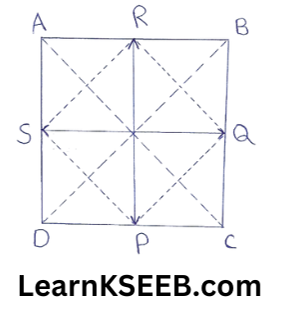
Construction: Join PQ, QR, RS, SP, AC & BD
Proof: In ΔABC
R & Q are the midpoints of AB & BC respectively
∴ RQ || AC and RQ=1/2AC
|| ly, we can show that
PS || AC &PS=1/2AC
∴ RQ || PS and RQ = PS
Thus a pair of opposite sides of a quadrilateral PQRS are parallel & equal.
∴ PQRS is a ||gm
Since the diagonals of a ||gm bisect each other.
∴ PR & QS bisect each other
7. ABC is a Δle right angled at C. A line through the midpoint M of hypotenuse AB & parallel to BC intersects AC at D. Show that
1) D is the midpoint of AC
2) MD ⊥ AC
3) CM = MA = 1/2AB
Solution:
Given : ABC is a Δle right angled at C. A line through the midpoint M of hypotenuse AB & parallel to BC intersects AC at D.

To prove : 1) D is the midpoint of AC
2) MD⊥AC
3) CM = MA = 1/2 AB
Proof: 1) In ΔACB
M is the midpoint of AB & MD || BC
∴ D is the midpoint of AC
(By converse of mid-point theorem)
2) MD || BC & AC intersects them
\(\lfloor\mathrm{ADM}\) = \(\lfloor\mathrm{ACM}\) (corresponding angles) But \(\lfloor\mathrm{ACB}\) = 90° (given)
∴ \(\lfloor\mathrm{ADM}\) = 90°
=> MD ⊥ AC
3) Now, \(\lfloor\mathrm{ADM}\) + \(\lfloor\mathrm{CDM}\) = 180° (linear pair)
\(\lfloor\mathrm{ADM}\) = \(\lfloor\mathrm{CDM}\) = 90°
In ΔADM & ΔCDM
AD = CD (∴ D is the midpoint of AC)
DM = DM (common)
\(\lfloor\mathrm{ADM}\) = \(\lfloor\mathrm{CDM}\) = 90°
∴ ΔADM ≅ ΔCDM (by SAS rule)
∴ MA = MC (CPCT)
But M is the midpoint of AB
∴ MA=MB= 1/2AB
∴ MA=MC= 1/2AB
=> CM = MA = 1/2AB
KSEEB 9th Standard Maths Chapter 8 Important Questions
Additional Questions
Choose the correct answer from the following
1. ABCD is a ||gm & X & Y are the midpoints of sides AB &CD respectively. Then the quadrilateral AXCYis
- a parallelogram
- a rectangle
- a rhombus
- a square
- Solution: 1. a parallelogram
2. In a quadrilateral three angles are in the ratio 3:3:1 & one of the angles is 80°, then other angles are
- 120°, 120°, 40°
- 100°, 100°, 80°
- 110°, 110°, 60°
- 100°, 100°, 90°
Solution: 1. 120°, 120°, 40°
3. If one angle of a ||gm is 90°, then the ||gm is called a
- kite
- rectangle
- rhombus
- Kite
Solution: 2. rectangle
4. The angle between the diagonals of a rhombus is
- 45°
- 90°
- 30°
- 60°
Solution: 2. 90°
5. In the following figure, ABCD is a ||gm. The value of x is

- 25°
- 60°
- 75°
- 45°
Solution: 4. 45°
6. In the following figure D, E & F are the midpoints of sides BC, CA & AB of ΔABC. If AB = 3cm, BC = 4cm & CA = 4cm, then the perimeter of ΔDEF is A

- 11cm
- 8cm
- 7cm
- 5.5.cm
Solution: 4. 5.5.cm
7. In figure, ABCD is a ||gm. The bisectors of angles A & B intersect at O. Then the angle AOB is
- a right angle
- an acute angle
- an obtuse angle
- a straight angle

Solution: 1. a right angle
8. In the given figure, ABCD &AEFG are two ||gm, If \(\lfloor C\) = 60°, then \(\lfloor\mathrm{GFE}\) is

- 60°
- 120°
- 30°
- 45°
Solution: 1. 60°
Fill in the blanks :
1. A quadrilateral whose diagonals are equal & bisect each other at right angles is called a square.
2. The angles of a quadrilateral are in the ratio 2:3:6:7. The largest angle of the quadrilateral is 140°
3. Two consecutive angles of a ||gm are in the ratio 1:3, then the smaller angles is 45°
4. In an equilateral Δle ABC, D & E are the mid-points of sides AB & AC respectively, Then length of DE is 1/2BC.
5. D, E, F are the midpoints of sides BC, CA&AB of ΔABC. If perimeter of AABC is 12.8cm then perimeter of ADEF is 6.4cm
Two Mark Questions
1. The angles of a quadrilateral are 4x°, 7x°, 15×0 & 10×0. Find the smallest & largest angles of the quadrilateral.
Solution: Sum of the angles of a quadrilateral is 360°.
4x+7x+15x+10x=360°
x=360/36=10°
∴ smallest angle = 4x°=40°
largest angle = 15x° = 150°
2. Two opposite angles of a ||gm are (3x-2)° & (63-2x)°. Find all the angles of a ||gm.
Solution: Since opposite angles of a ||gm are equal (3x-2)° = (63-2x)°
=> x=13°
Angles of a parallelogram are (39-2)°, (180-37), (63-26), (180-36)°
ie, 37°, 143°, 37°, 143°
3. Two parallel lines l & m are intersected by a transversal ‘l’ .Show that the quadrilateral formed by bisectors of interior angles is a rectangle.
Solution:

\(\lfloor\mathrm{APR}\) – \(\lfloor\mathrm{DRP}\) (alternate interior angles)
or \(\lfloor 1\) = \(\lfloor 2\)
But these are alternate interior angles.
SP || RQ, SR || PQ
PQRS is a ||gm
\(\lfloor\mathrm{APR}\) +\(\lfloor\mathrm{BPR}\) =180° (linear pair)
=> 1/2\(\lfloor\mathrm{APR}\) + 1/2\(\lfloor\mathrm{BPR}\) =90°
\(\lfloor 1\) + \(\lfloor 3\) = 90°
=> \(\lfloor\mathrm{SPQ}\) = 90°
∴ PQRS is a rectangle
4. In a ||gm, show that the angle bisectors of two adjacent angles intersect at right angle.
Solution:
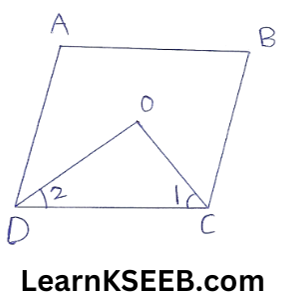
\(\lfloor\mathrm{ADC}\) +\(\lfloor\mathrm{BCD}\) = 180°
=>1/2\(\lfloor\mathrm{ADC}\) + 1/2\(\lfloor\mathrm{BCD}\) = 90°
OR \(\lfloor 1\)+\(\lfloor 2\) = 90°
In ΔODC,
\(\lfloor 1\)+\(\lfloor 2\) + \(\lfloor\mathrm{DOC}\) = 180°
90°+ \(\lfloor\mathrm{DOC}\) = 180°
=> \(\lfloor\mathrm{DOC}\) = 180°-90°
∴ \(\lfloor\mathrm{DOC}\) = 90°
5. The angle between the two altitudes of a ||gm through the vertex of an obtuse angle is 50°. Find the angles of a ||gm.
Solution:
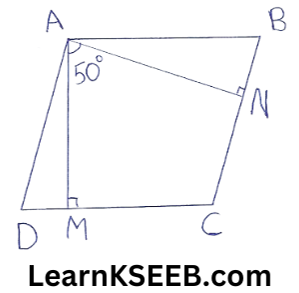
AM ⊥ DC, AN ⊥ BC
In Quadrilateral AMCN
\(\lfloor A\) + \(\lfloor M\)+ \(\lfloor C\) + \(\lfloor N\) = 360°
∴ \(\lfloor A\) + \(\lfloor C\) = 360° -90° -90°
∴ \(\lfloor A\) + \(\lfloor C\) = 180°
=>50°+\(\lfloor C\) = 180°
=>\(\lfloor C\) = 180°-50°
\(\lfloor C\) = 130°
In ||gm, [A = \(\lfloor C\) = 130°
\(\lfloor D\) = \(\lfloor B\) = 180° -130° = 50°
6. ABCD is a ||gm. If E is the midpoint of BC & AE is the bisector of \(\lfloor A\). Prove that AB = 1/2AD
Solution:

Here \(\lfloor 1\) = \(\lfloor 2\)
(AE is the angle bisector) \(\lfloor 1\) = \(\lfloor 3\) (alternate angles as AD || BC)
\(\lfloor 3\) = \(\lfloor 2\)
Hence BE =AB
(sides opp. to equal angles)
but BE =1/2BC (E is the midpoint of BC)
∴ AB = 1/2BC
& BC = AD (opp. sides of a ||gm)
∴ AB = 1/2AD
7. D, E & F are the midpoints of sides PQ, QR & RP respectively of an equilateral ΔPQR. Show that ΔDEF is also an equilateral Δle.
Solution:

DE || PR & DE = 1/2PR (midpoint theorem)
EF || PQ & EF = 1/2PQ (midpoint theorem)
DF || QR & DF = 1/2QR (mid-point theorem)
also PQ = QR = PR (∵ PQR is an equilateral Δle)
=> DE = EF = DF
=> ADEF is an equilateral Δle.
8. In ΔABC, D, E & F are the midpoints of sides AB, BC & CA. If AB = 6cm, BC = 7.2cm & AC = 7.8cm, find the perimeter of ΔDEF
Solution:

DE = 1/2AC
EF = 1/2AB {Midpoint theorem}
DF = 1/2BC
Perimeter of DEF = DE + EF + DF
= 1/2(AC + AB + BC)
= 1/2(7.8 + 6 + 7.2)
= 1/2×21 = 10.5cm
Three Mark Questions
1. In a ||gm PQRS of the given s figure, the bisectors of \(\lfloor P\) & \(\lfloor Q\) meet SR at O. Show that \(\lfloor\mathrm{POQ}\) = 90°

Solution: PQRS is a ||gm
=> PS || QR
PS || QR & transversal
PQ intersects them.
∴ \(\lfloor P\) + \(\lfloor Q\) = 180°
(sum of consecutive interior angles is 180°)
1/2\(\lfloor P\) + 1/2\(\lfloor Q\) = 90°
=> \(\lfloor 1\)+\(\lfloor 2\) = 90° (∵ OP is bisector of \(\lfloor P\) & OQ is bisector of \(\lfloor Q\))
∴ \(\lfloor 1\) = 1/2\(\lfloor P\) & 1/2\(\lfloor Q\)
Now, in APOQ
\(\lfloor 1\)+ \(\lfloor 2\) + \(\lfloor\mathrm{POQ}\) = 180°
90°+ \(\lfloor\mathrm{POQ}\) = 180°
=> \(\lfloor\mathrm{POQ}\) = 90°
2. In a quadrilateral ABCD, the line segment bisecting \(\lfloor C\) & \(\lfloor D\) meet at E. Prove that \(\lfloor A\) + \(\lfloor B\) = 2\(\lfloor\mathrm{CED}\)
Solution:
Given: In a quadrilateral ABCD, the line segments bisecting \(\lfloor C\), & \(\lfloor D\) meet
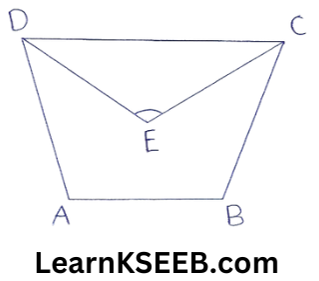
To prove: \(\lfloor A\)+\(\lfloor B\) = 2\(\lfloor\mathrm{CED}\)
Proof: In quadrilateral ABCD,
\(\lfloor A\) + \(\lfloor B\) + \(\lfloor C\)+ \(\lfloor D\) = 360° ………………….(1)
In ACED,
\(\lfloor\mathrm{CED}\) + \(\lfloor\mathrm{EDC}\) + \(\lfloor\mathrm{ECD}\) = 180° (angle sum property)
=> \(\lfloor\mathrm{CED}\) + 1/2 \(\lfloor D\)+ 1/2\(\lfloor C\) = 180°
=> 2\(\lfloor\mathrm{CED}\) + \(\lfloor D\)+ \(\lfloor C\) = 360° ………………..(2)
from(1) &(2)
2\(\lfloor\mathrm{CED}\) + \(\lfloor D\) + \(\lfloor C\) = \(\lfloor A\) + \(\lfloor D\) + \(\lfloor C\) + \(\lfloor D\)
=> 2\(\lfloor\mathrm{CED}\) = \(\lfloor A\) + \(\lfloor B\)
=> \(\lfloor A\) + \(\lfloor B\) = 2\(\lfloor\mathrm{CED}\)
Karnataka Board Class 9 Maths Chapter 8 MCQs
3. Prove that A diagonal of a ||gm divides it into two congruent triangles.
Solution:

ABCD is a ||gm. AC is a diagonal of ABCD which divides it into two Δles,
ie, ΔABC & ΔCDA.
To prove: ΔABC ≅ ΔCDA
Proof: BC || DA & AC is a transversal
∴ \(\lfloor\mathrm{BCA}\) = \(\lfloor\mathrm{DAC}\) …………………….(1) (alternate angles)
also AB || DC & AC is transversal
∴ \(\lfloor\mathrm{BAC}\) = \(\lfloor\mathrm{DCA}\) (alternate angles)
AC = CA = (3) (common)
∴ ΔABC ≅ ΔCDA
4. ABC is an isosceles Δle in which AB = AC. AD bisects \(\lfloor\mathrm{PAC}\) and CD ||AB Show that
1) \(\lfloor\mathrm{DAC}\) = \(\lfloor\mathrm{BCA}\)
2) ABCD is a ||gm

Solution:
Given: ABC is an isosceles Δle in which AB = AC.
AD bisects |PAC &CD || AB
To prove: 1) \(\lfloor\mathrm{DAC}\) = \(\lfloor\mathrm{BCA}\) 2) ABCD is a ||gm
Proof: (1) In ΔABC
AB = AC
=> \(\lfloor B\) = \(\lfloor C\) (Angles opp to equal sides of a Δle are equal)
Also exterior \(\lfloor\mathrm{PAC}\) + \(\lfloor B\) + \(\lfloor C\)
=> \(\lfloor\mathrm{PAC}\) = \(\lfloor C\) + \(\lfloor C\)
=> \(\lfloor\mathrm{PAC}\) = \(\lfloor C\) + \(\lfloor C\)
=> 2\(\lfloor\mathrm{CAD}\) = 2\(\lfloor C\) (∵ AD bisects |PAC)
=> \(\lfloor\mathrm{CAD}\) = \(\lfloor C\)
=>\(\lfloor\mathrm{DAC}\) = \(\lfloor\mathrm{BCA}\)
2) But these angles form a pair of equal alternate interior angles.
∴ AD || BC
also CD || AB
ABCD is a ||gm
(a quadrilateral is a Is ||gm if its both the pairs of opposite sides are parallel)
5. In Δle ABC points M &N on sides AB & AC respectively are taken so that AM = 1/4AB & AN = 1/4AC. Prove that MN = 1/4BC.
Solution:
E is the mid-point of AB &F is the mid-point of AC.

∴ EF || BC & EF = 1/2BC ………………..(1)
Now, AE = 1/2 AB
and AM = 1/4 AB
AM = 1/2AE
||ly AN= 1/2 AF
=> M & N are the mid-points of AE & AF respectively.
∴ MN || EF &
MN= 1/2 EF = 1/2×1/2BC (from(1))
=> MN = 1/4BC
6. In given fig, AD is the median of ΔABC, E is the mid-point of AD, DG || BE. Prove that AC = 3 A F.

Solution:
In ΔADG, E is the mid-point of AD & EF || DG

=> F is the mid-point of AG (Converse of midpoint theorem)
AF = FG ……………………..(1)
In ΔCBF, BF || DG, D is the mid-point of BC
=> G is the mid-point of FC.
=> FG=GC ………………….(2)
from(1)&(2)
AF = FG = GC
AC = AF + FG + GC
AC = AF + AF + AF
=>AC = 3 AF
Four Mark Questions
1.ABCD is a ||gm & line segments AX, CY bisects the angles A & C respectively. Show that AX || CY
Solution:
ABCD is a ||gm

=>\(\lfloor A\)=\(\lfloor C\) (opp angle)
=> 1/2\(\lfloor A\)=1/2\(\lfloor C\) (Halves of equals are equal)
=> \(\lfloor 1\)=\(\lfloor 2\) (∵ AX is the bisector of A & CY is the bisector of C)
Now, AB || DC & CY intersects them
∴ \(\lfloor 2\)–\(\lfloor 3\) ……………….(2) (alternate interior angle)
from (1) & (2) we get \(\lfloor 1\)–\(\lfloor 3\)
But these form a pair of equal corresponding angles.
∴ AX || CY
Class 9 Maths Quadrilaterals KSEEB Guide
2. Vicky has a photo-frame without a photo in the shape of a Δle with sides a, b, c, in length. He wants to find the perimeter of a Δle formed by joining the mid-points of the sides of the photo frame. He could not understand how to over come this problem. He shares this problem with his classmate Somu. Somu helps him & the required perimeter is computed.
1) Find the perimeter of the Δle formed by joining the mid-points of the frame.
2) Which value is depicted between Vicky & Somu.
Solution:
1) Let the photo frame be ABC such that BC=a, CA=b & AB=c & the mid-points of AB, BC & CA are respectively D, E & F.
We have to determine the perimeter of A DEF.
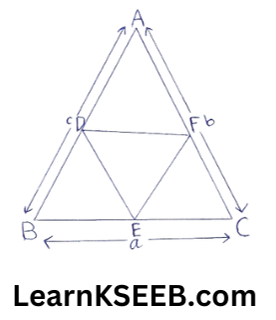
In ΔABC, DF is the line segment joining the mid-points of sides AB & AC.
So, DF is ||le to BC & half of it
i.e \(\mathrm{DF}=\frac{\mathrm{BC}}{2}=\frac{a}{2}\)
|| ly \(\mathrm{DE}=\frac{\mathrm{AC}}{2}=\frac{\mathrm{b}}{2}\)
& \(\mathrm{EF}=\frac{\mathrm{AB}}{2}=\frac{\mathrm{c}}{2}\)
∴ \(\mathrm{DF}+\mathrm{DE}+\mathrm{EF}=\frac{\mathrm{a}}{2}+\frac{\mathrm{b}}{2}+\frac{\mathrm{c}}{2}\)
\(=\frac{a+b+c}{2}\)Hence required perimeter \(=\frac{a+b+c}{2}\)
2) Unity & cooperation or Mutual understanding.
3. ABCD is a square & on the side DC, an equilateral Δle is constructed. Prove that
1) AE = BE
2) \(\lfloor\mathrm{DAE}\) =15°
Solution: 1) Since ABCD is a square & ΔDCE is an equilateral Δle.
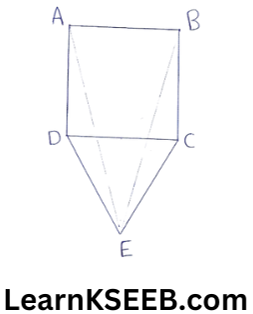
∴ \(\lfloor\mathrm{ADC}\) = 90°
∴ \(\lfloor\mathrm{EDC}\) = 60°
=> \(\lfloor\mathrm{ADC}\) + \(\lfloor\mathrm{EDC}\) = 90 + 60°
=> \(\lfloor\mathrm{APE}\) = 150°
|| Iy we have \(\lfloor\mathrm{BCE}\) = 150°
Thus in ΔADE & ΔBCE, we have
AD = BC
\(\lfloor\mathrm{DAE}\) = \(\lfloor\mathrm{BCE}\) = 150°
DE = CE
=> ΔADE ≅ ΔBCE (bySAS sule)
=> AE = BE (C.P.C.T)2) In AEAD , we have AD = DE
\(\lfloor\mathrm{EAD}\) = \(\lfloor\mathrm{AED}\) = x
Now \(\lfloor\mathrm{APE}\) + \(\lfloor\mathrm{AED}\) + \(\lfloor\mathrm{DAE}\) = 180°
150° + x + x= 180°
2x = 180°-150°
2x = 30°
=> x= 15°
=> \(\lfloor\mathrm{DAE}\) = 15°
4. There was four plants in Suraj’s fields. Suraj named their bases of P,Q, R & S. He joined PQ, QR, RS & SP. His teacher told him that the quadrilateral PQRS is ||gra. He asked him to find the measure of all the angles of the ||gm, provided that the measure of any one interior angle of PQRS. To obtain a technique & hence to solve the problem, he worked hard & spent much time.
1) Obtain all the angles of the ||gm PQRS if [R = 55°.
2) Which mathematical concept is used in the above problem?
3) Which value was depicted by Suraj on such a problem?
Solution:
1) \(\lfloor R\) = 55° (given)
SR || PQ & RQ is a transversal
∴ \(\lfloor R\) + \(\lfloor Q\) = 180°

55° + \(\lfloor Q\) = 180° (Co-interior angles)
\(\lfloor Q\) = 180° -55°
= 125°
\(\lfloor R\) = \(\lfloor P\) = 55°
\(\lfloor Q\) = \(\lfloor S\) = 125° (opp angles of a \\m are equal)
∴ \(\lfloor P\) = 55°, \(\lfloor Q\) = 125°, \(\lfloor R\) = 55° & \(\lfloor S\) = 125°
2) Property of Co-interior angles when a pair of straight lines intersected by another straight line.
3) Dedication, determination & Hard work.
5. ABCD is a rhombus & AB is produced to E & F such that AE = AB = BF. Prove that ED & FC are perpendicular to each other.
Solution:
Given: ABCD is a rhombus AB produced to E & F, such that AE = AB = BF
To prove: ED ⊥ FC

Construction: Join ED & CF & produce it to meet at G
Proof: AB is produced to point G & F
such that AE = AB = BF ………………..(1)
ABCD is a Rhombus
=> AB = BC = CD=AD …………………(2)
In ABCF
BC = BF (from (1) & (2))
=> \(\lfloor 1\)= \(\lfloor 2\)
\(\lfloor 3\) = \(\lfloor 1\) + \(\lfloor 2\) (exterior angle) …………………(3)
|| ly AE = AD
\(\lfloor 5\)= \(\lfloor 6\)
=> \(\lfloor 4\)= \(\lfloor 5\)+ \(\lfloor 6\) = 2\(\lfloor 5\) ………………..(4)
adding (3) & (4) we get
\(\lfloor 4\) + \(\lfloor 3\) = 2\(\lfloor 2\) + 2\(\lfloor 5\)
=> 180° = 2 (\(\lfloor 2\) + \(\lfloor 5\))
(∵ \(\lfloor 4\) & \(\lfloor 3\) are consecutive interior angles)
=> \(\lfloor 5\) + \(\lfloor 2\) = 90°
In ΔEGF
EG ⊥ FC
\(\lfloor 5\) +\(\lfloor 2\) + \(\lfloor\mathrm{EGF}\) = 180°
\(\lfloor 5\) + \(\lfloor 2\) =90°
=> 90° \(\lfloor\mathrm{EGF}\) = 180°
=> \(\lfloor\mathrm{EGF}\) = 90°
=> ED ⊥ FC
Hence proved
KSEEB Class 9 Maths Chapter 8 Exercise Solutions
6. In the given figure, bisectors of [B & [D 0f quadrilateral ABCD meet CD & AB produced at P & Q respectively. Prove that: \(\lfloor P\) + \(\lfloor Q\) =\(\frac{1}{2}(\lfloor\mathrm{ABC}+\lfloor\mathrm{ADC})\)
Solution:
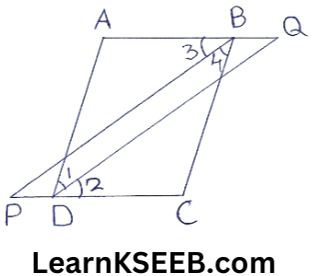
In ΔPBC, we have
\(\lfloor P\) + \(\lfloor 4\) + \(\lfloor C\) = 180°
=> \(\lfloor P\) + 1/2 \(\lfloor B\) + \(\lfloor C\) =180° ……………..(1)
In, ΔQAD, we have \(\lfloor Q\) + \(\lfloor A\) + \(\lfloor 1\) = 180°
=> \(\lfloor Q\) + \(\lfloor A\)+1/2\(\lfloor D\) = 180° ………………..(2)
adding (1) & (2) we get
\(\lfloor P\) + \(\lfloor Q\) + \(\lfloor A\) + \(\lfloor C\) + 1/2\(\lfloor B\)+1/2\(\lfloor D\) = 180 + 180
=>\(\lfloor P\) + \(\lfloor Q\) + \(\lfloor A\) + \(\lfloor C\)+1/2(\(\lfloor B\) + \(\lfloor D\)) = 360°
But \(\lfloor A\) + \(\lfloor B\) + \(\lfloor C\) + \(\lfloor D\) = 360°
(Sum of the angles of a quadrilateral)
∵ \(\lfloor P\) + \(\lfloor Q\) + \(\lfloor A\) + \(\lfloor C\)+1/2 (\(\lfloor B\) + \(\lfloor D\))
= \(\lfloor A\) + \(\lfloor B\) + \(\lfloor C\) + \(\lfloor D\)
=>\(\lfloor P\) + \(\lfloor Q\) = 1/2(\(\lfloor B\) + \(\lfloor D\))
=> \(\lfloor P\) + \(\lfloor Q\) = 1/2 (\(\lfloor\mathrm{ABC}\) + \(\lfloor\mathrm{ADC}\))
7. In the figure, ABCD is a ||gm & | DAB =60°. If the bisectors AP & BP of angles A & B respectively meet at P on CD. Prove that P is the mid-point of CD.
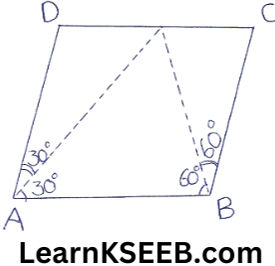
Solution: We have \(\lfloor\mathrm{DAB}\) = 60°
\(\lfloor A\) + \(\lfloor B\) = 180°
=> 60 + \(\lfloor B\) = 180°
=> \(\lfloor B\) = 180° – 60° = 120°
Now, AB || BC & transversal AP intersects them
\(\lfloor\mathrm{PAB}\) = \(\lfloor\mathrm{APD}\)
=> \(\lfloor\mathrm{APD}\) 30° (∵ \(\lfloor\mathrm{PAB}\) = 30°)
Thus in ΔAPD, we have
\(\lfloor\mathrm{PAD}\) = \(\lfloor\mathrm{APD}\)
=> AD = PD …………….(1)
(Angles opp to equal sides are equal)
Since BP is the bisector of \(\lfloor B\)
∴ \(\lfloor\mathrm{ABP}\) = \(\lfloor\mathrm{PBC}\) = 60°
Now, AB || DC & transversal BP intersects them
∴ \(\lfloor\mathrm{CPB}\) – \(\lfloor\mathrm{ABP}\)
=> \(\lfloor\mathrm{CPB}\) = 60°
Thus in ΔCBP, we have
\(\lfloor\mathrm{CBP}\) = \(\lfloor\mathrm{CPB}\) (each equal to 60°)
=> CP = BC (Sides opp. to equal angles are equal)
=> CP = AD ………………..(2)
(ABCD is a || gm , AD = BC)
from (1) & (2) we get
PD = CP
P is the mid-point of CD.
